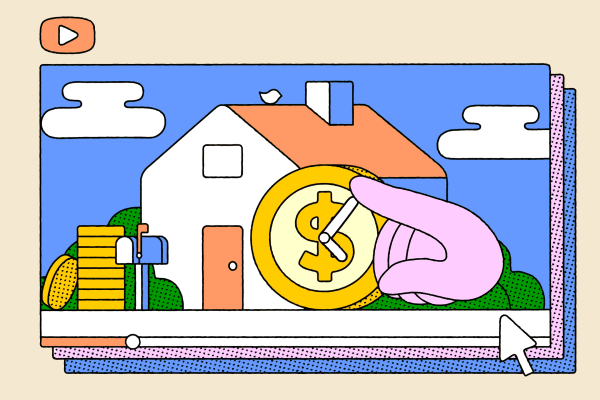YouTube's Favorite Mortgage Strategy Has Millions of Fans. Here's How It Actually Works

The most popular video on Sam Kwak’s YouTube channel has 3.5 million views. It’s nothing fancy. Just a half hour of Kwak talking. A few sheets of printer paper and a thick black Sharpie his only props. But it offers something viewers can’t resist: the promise of magically paying off a mortgage at extraordinary speed.
“Mortgages kind of suck,” he declares, sitting in a glass enclosed conference room, an empty office spread out behind him.
Kwak, now 28, posted the video in September 2017 after learning about the strategy at a seminar. The video lays out a scheme he claims can help borrowers pay off a 30-year mortgage in just seven years and save tens of thousands of dollars in interest. A follow-up published in May 2019 has been viewed over 900,000 times, including a big surge in traffic around the start of the coronavirus pandemic in March.
Numbers like that make Kwak and his brother Daniel perhaps the highest-profile proponents of a strategy sometimes called “velocity banking” or “debt acceleration.” The scheme is nothing new, but has caught fire on YouTube in recent years with dozens of tutorials published to the site, many receiving over 100,000 views.
Like Kwak’s, most of the videos are relatively simple productions. In one of the most popular, a woman walks through the process by drawing stick figures on a white board surrounded by Christmas lights. In another, a man shares his screen as he plugs numbers into an Excel spreadsheet. Many appear to recycle the same Powerpoint slides that show a hypothetical borrower with a moderate income but enormous savings.
The tone suggests that you’re being let in on a secret that will give you the upper hand over your lender. Commenters have described the trick as, “robbing Peter to pay Paul.”
The basic idea is to strategically spread your money across different debt products in order to minimize interest payments and maximize the amount going to pay down your mortgage principal. However, it only works if you spend less than you earn — ideally by a lot. If anything goes wrong you could end up owing big money on a high-cost line of credit, rather than a relatively low-cost mortgage. In extreme cases you also risk losing your house.
While the gimmick offers some lessons on how mortgages work and how to make yours work for you, in practice it is an incredibly risky game of what professional investors call arbitrage, or taking advantage of small discrepancies in prices or, in this case, interest rates.
“How financially capable and savvy are you?” ask Nicole Rueth, a mortgage advisor who leads a team for Fairway Mortgage in Denver. While the strategy works in some cases, if it’s not done properly the results can be “devastating,” she says. “The moment you trip is the moment the house of cards falls down.”
How velocity banking is supposed to work (and what could really happen)
Step 1: Take out a mortgage.
If you have a $300,000 mortgage with a 30-year payment term and a fixed 3% interest rate, you’ve agreed to pay your lender $1,265 each month for 360 months. That’s adds up to a total of $155,000 in interest if you see the loan through.
(Kwak wasn’t wrong when he told his viewers, “You essentially bought the bank another house while paying for yours.”)
Still, it has never been cheaper to borrow money for a home. Benchmark mortgage rates averaged 2.68% in December, a record low. For context, rates peaked at 18.45% in the 1980s. So if you can afford your monthly payment and this where you decide to stop, rest assured you are getting a good deal historically.
Step 2: Take out a HELOC.
Next, you would apply for a home equity line of credit, better known by the acronym HELOC. Like a credit card, a HELOC is a revolving line of credit, but the debt is secured by your home. Borrowers typically use HELOCs to pay for home improvement projects or other large recurring expenses.
HELOCs have much lower interest rates than credit cards, but that doesn’t mean they are risk free. Right now the average interest rate on a home equity line is around 3.92%, but the range of potential rates is wide. The interest rate on a HELOC is also variable, meaning the rate resets after an initial fixed period.
Given the current low rates, there is a good chance your rate will go up later on, which could make the math behind the velocity banking strategy harder. Lenders have also been known to close off credit lines when the economy is bad, though that has not happened during the current downturn. Finally, the line typically takes a second lien position behind your primary mortgage, so your lender can foreclose if you can’t pay.
Step 3: Use your HELOC to pay your mortgage.
The gamesmanship begins once you have both loans in place. Instead of using your HELOC to, say, renovate a bathroom, velocity banking advocates say you should use it to pay down part of your original mortgage. Proponents sometimes call this “chunking.”
So if you borrowed $10,000 from your HELOC and used that to pay your mortgage you would reduce the amount you owe from $300,000 to $290,000. That one extra payment would eventually save you about $14,000 in interest and mean paying off your mortgage 18 months early.
How? The interest you owe on a mortgage is calculated monthly. To determine how much you owe, your lender multiples your outstanding balance by your mortgage rate and divides by 12. So in the first month of our example mortgage $750 of the $1,265 monthly payment would cover interest and the remainder would go toward principal.
As you chip away at your loan balance with regular payments, a little more goes toward the principal each month. This process is called amortization and you can speed it up by paying extra — in this case with a HELOC.
Step 4: Get your HELOC balance to zero — ASAP.
Of course, paying your mortgage with a HELOC just shifts the balance from one kind of debt to another. For most people that would be a red flag, but proponents of velocity banking see this as the magic of their strategy.
Because a HELOC is revolving — meaning you can pay it back and reuse it anytime — interest payments are calculated using the daily average balance. Kwak says it took him two months of messing around with an Excel spreadsheet to realize that meant you save on interest if you maintain a low balance for as many days of the month as possible. To achieve this he recommends using whatever cash you have to lower the HELOC balance.
To keep it lower for longer, he says, you can put all your expenses on a credit card. If you pay off your credit card at the end of the month it amounts to a month of interest free borrowing. (Be very careful. Credit card APRs can be north of 20% — if you miscalculate you’ll be left with a large balance on the highest interest debt around.) It's the financial equivalent of juggling with three balls — a mortgage, a HELOC and a credit card.
“It’s the math side of it, how you structure when the income goes in and the expenses go out that seems to be the factor in the success of the strategy,” says Kwak.
However, Kwak admits that this whole process saves just a few bucks. To get the results promised in his and others’ videos, you need to repeat the steps over and over and over.
Moreover, for the strategy to work at all, the amount you owe on the line of credit needs to actually go down from one month to the next. This is only possible if you consistently spend less than you earn. The more you save, the faster the process goes. So as a model, many videos use a person with a $60,000 annual income, who saves more than 25% of that.
In February 2020, just before coronavirus hit, the personal savings rate in America was about 8%. If you are the rare person able to save a lot more — after putting money away for an emergency and retirement — this strategy may work for you. But there are far simpler options.
How to — safely — pay off your mortgage early
You can replicate the benefits of “chunking,” by funneling a windfall like a tax refund, a bonus or a stimulus check to your mortgage. Putting, for example, a $10,000 bonus toward a $300,000 mortgage would reap the same benefits as in the HELOC example. Just confirm with your lender that the funds will be used for principal rather than interest payments.
If you don’t expect a big check anytime soon, an extra $50 a month on that $300,000 mortgage (so $1,315 instead of $1,265), would get you to a zero balance in 339 months instead of 360 (a reduction of nearly two years) and save you over $10,000 in interest. Ask your lender if you can automate recurring extra payments so you don’t have to think about it.
Jack Guttentag, a former finance professor at the University of Pennsylvania, has a helpful extra payment calculator on his Mortgage Professor blog. “Large savings require larger payments,” warns Guttentag in a post. “The trick is to find a pattern of extra payments that you can live with.”
More from Money:
How to Make Your Savings Last for Decades, According to a 96-Year-Old Retirement Expert
Home Equity Is Soaring — if You're Tempted to Borrow Against Your Home, Read This First
Low Rates Are Putting 15-Year Mortgages — and Big Savings — Within Reach for Millions of Homeowners

